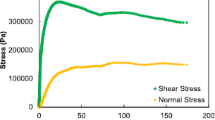Abstract
The Viscoelastic Continuum Damage (VECD) model has been implemented into a finite element package (FEP++) to predict the fatigue performance of asphalt concrete (AC) mixtures tested at the Federal Highway Administration Accelerated Load Facility (FHWA ALF) and the Korea Expressway Corporation (KEC) test road project sites. Both the VECD model and the FEP++ were developed at North Carolina State University. The conceptual approach taken for this research is to separate the characteristics of the pavement system that are related to the material from those related to the boundary conditions. It is believed that this study is the first application of an integrated structural/material mechanistic model for the fatigue performance prediction of AC pavements where damage in the asphalt layers is considered for the full time history and where the change in stiffness due to damage evolution is captured in the subsequent calculation of damage. The VECD model accounts for the viscoelastic nature of AC mixtures with growing damage, whereas the finite element model accounts for other important characteristics, such as temperature, layer thickness, stiffness gradient, etc. The controlled FHWA ALF experiment allows a direct comparison between observed and modeled fatigue performance. Because the KEC test road experiment is subjected to real and variable traffic and environmental factors, the finite element simulation results are used to examine the effects of specific parameters in the pavement system on fatigue performance. In this regard, the model is found to effectively capture the effects of changes in layer thickness, layer material, and layer type. The need to develop transfer functions for true field performance prediction is also shown, and a simple example function is developed as proof of this concept.
Similar content being viewed by others
References
Al-Khateeb, G., Gibson, N., and Qi, X. (2007). “Mechanistic analyses of FHWA’s accelerated loading facility pavements: Primary response.” Transportation Research Record 1990. National Research Council, Washington, D.C., pp. 150–161.
Chehab, G. (2002). Characterization of Asphalt Concrete in Tension Using a Viscoelastoplastic Model. Ph.D. dissertation, North Carolina State University, Raleigh, NC.
Chehab, G., Kim, Y. R., Schapery, R. A., Witczack, M., and Bonaquist, R. (2002). “Time-temperature superposition principle for asphalt concrete mixtures with growing damage in tension state.” Asphalt Paving Technology, AAPT, Vol. 71, pp. 559–593.
Daniel., J. S. (2001). Development of a Simplified Fatigue Test and Analysis Procedure Using a Viscoelastic, Continuum Damage Model and its Implementation to WesTrack Mixtures. Ph.D. dissertation, North Carolina State University, Raleigh, NC.
Daniel, J. S. and Kim, Y. R. (2002). “Development of a simplified fatigue test and analysis procedure using a viscoelastic continuum damage model.” Asphalt Paving Technology, AAPT, Vol. 71, pp. 619–650.
Kaloush, K. (2001). Simple Performance Test for Permanent Deformation of Asphalt Mixtures. Ph.D. disseration, Arizona State University, Tempe, AZ.
Kim, Y. R. and Little, D. N. (1990). “One-dimensional constitutive modeling of asphalt concrete.” ASCE Journal of Engineering Mechanics, Vol. 116, No. 4, pp. 751–772.
Lee, H. J. (1996). Uniaxial Constitutive Modeling of Asphalt Concrete Using Viscoelasticity and Continuum Damage Theory. Ph.D. dissertation, North Carolina State University, Raleigh, NC.
Lee, H. J. and Kim, Y. R. (1998). “A Uniaxial viscoelastic constitutive model for asphalt concrete under cyclic loading.” ASCE Journal of Engineering Mechanics, Vol. 124, No. 1, pp. 32–40.
Mun, S., Chehab, G. R., and Kim, Y. R. (2007). “Determination of time-domain viscoelastic functions using optimized interconversion techniques.” Road Materials and Pavement Design. Lavoisier, In Print.
Qi, X., Mitchell, T., Stuart, K., Youtcheff, J., Petros, K., Harman, T., and Al-Khateeb, G. (2004). “Strain responses in ALF modified-binder pavement study.” 2nd International Conference on Accelerated Pavement Testing, Minneapolis, MN.
Schapery, R. A. (1984). “Correspondence principles and a generalized Jintegral for large deformation and fracture analysis of viscoelastic media.” Int. Journal of Fracture, Vol. 25, pp.195–223.
Underwood, B. S., Kim, Y. R., and Guddati, M. N. (2006). “Characterization and performance prediction of ALF mixtures using a viscoelastoplastic continuum damage model.” Asphalt Paving Technology, AAPT Vol. 75, pp. 577–636.
Author information
Authors and Affiliations
Corresponding author
Rights and permissions
About this article
Cite this article
Kim, Y.R., Baek, C., Underwood, B.S. et al. Application of viscoelastic continuum damage model based finite element analysis to predict the fatigue performance of asphalt pavements. KSCE J Civ Eng 12, 109–120 (2008). https://doi.org/10.1007/s12205-008-0109-x
Published:
Issue Date:
DOI: https://doi.org/10.1007/s12205-008-0109-x




